From cinematic scores to personal voice-overs, music plays a very important role in creating the right mood for the videos. So, whether you are editing your next travel vlog for YouTube or fine-tuning one short for TikTok, knowing how to add music to iMovie can instantly level up your video. However, here’s the thing - iMovie offers more than one way to add music, which confuses most of the new iMovie users.
In this comprehensive guide, we will walk you through multiple processes so you can learn how to attach music to iMovie on iPhone and Mac . Whether you are pulling tracks from your Apple Garage Band, importing from Files, or using Apple’s built-in soundtracks, everything you need to know about importing music to iMovie is here.
In this article
- Part 1. How to Add Music to iMovie on iPhone with Built-in Music Resources
- Part 2: How to Add Music to iMovie on iPhone Using Audio from a Recorded Video
- Part 3: How to Add Music to iMovie on Mac Using Built-in Music Resources
- Part 4: How to Add Music to iMovie on Mac Using Audio from Uploaded Video Files
- Part 5. How to Batch Enhance Video Sound or Stereo Effect
- Part 6: Conclusion
- Part 7: FAQs
Part 1. How to Add Music to iMovie on iPhone with Built-in Music Resources
If you are using iMovie on your iPhone, the easiest way to add background music is by using Apple’s built-in soundtracks or built-in music resources. These are royalty-free music clips preloaded or downloadable directly within iMovie. In the built-in music resources, you will find multiple genres, like cinematic, pop, chill, action, and more.
Here’s how you can add built-in music to your iMovie project on iPhone:
Step 1
Launch the iMovie app on your iPhone. Tap Movie under the "Start New Project" section. This lets you manually select video clips and photos. Add a video to begin editing, and it will appear on your timeline as shown.
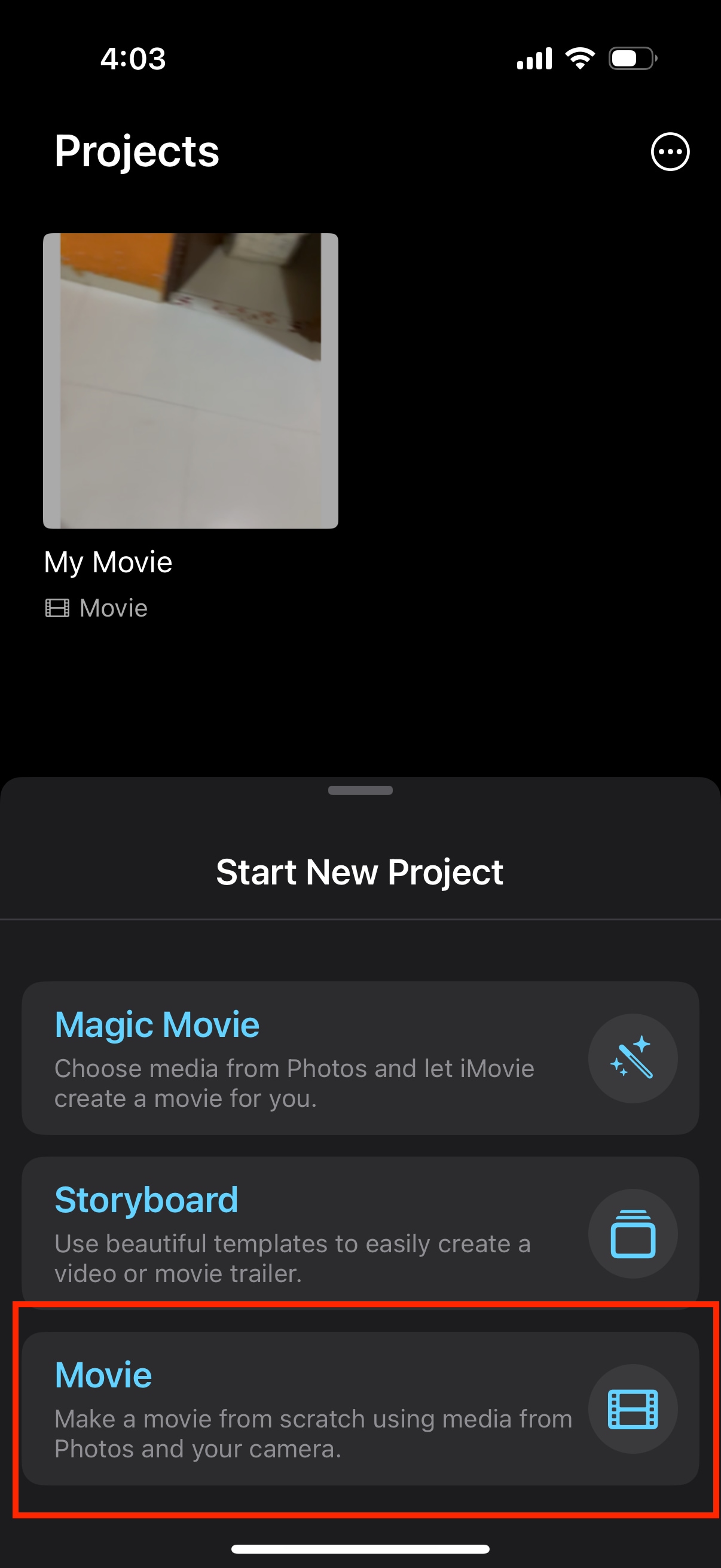
Step 2
Tap the plus (+) button located just above your timeline. This opens up the media selection menu. From here, tap on Audio.
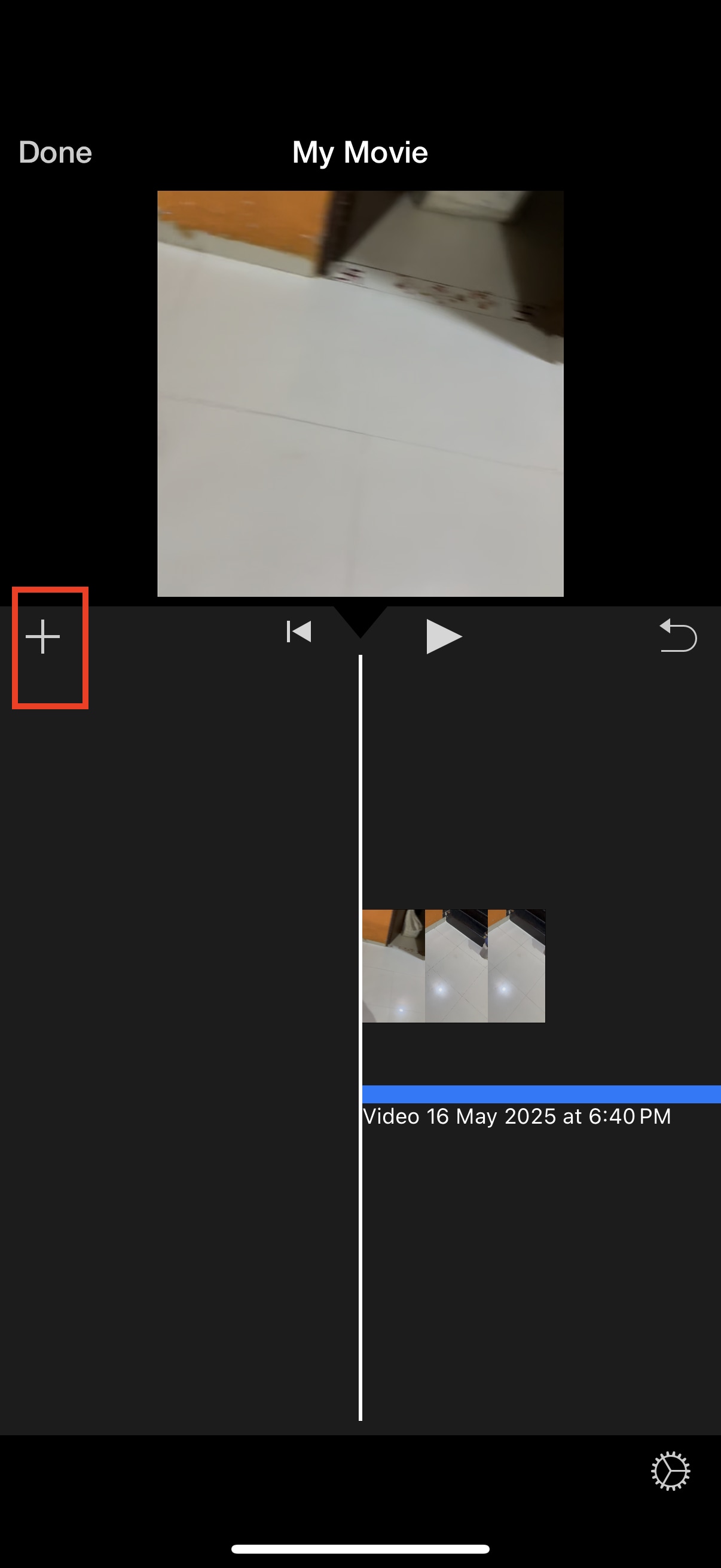
Step 3
In the Audio section, tap on Soundtracks. You will see a categorized list of available tracks: some might require a quick download (indicated by a cloud icon). Tap on any track to preview it.

Step 4
Once you find a suitable track, tap the plus (+) icon beside it. iMovie will automatically add the full track to your project timeline, syncing it under your video layer. The music clip appears in green, labeled with its name (like Run It Out in the attached screenshot).

Video Sound Effect Enhancer on Win and Mac
Part 2: How to Add Music to iMovie on iPhone Using Audio from a Recorded Video
If you have recorded a video earlier and want to reuse just its music or voice as background audio for a new project, iMovie gives you a neat trick where you can detach the audio from your old clip and repurpose it.
Here’s how you can do it on your iPhone:
Step 1
Open iMovie, tap Movie, and add the video on which you want to use music.
Step 2
Tap the plus (+) icon and select the video clip that contains the audio or background music you wish to reuse. Once added, it will appear on the timeline.
Step 3
Tap the video in the timeline to select it. From the bottom toolbar, tap Detach, and the audio track will now appear separately as a blue or green audio bar below the video.
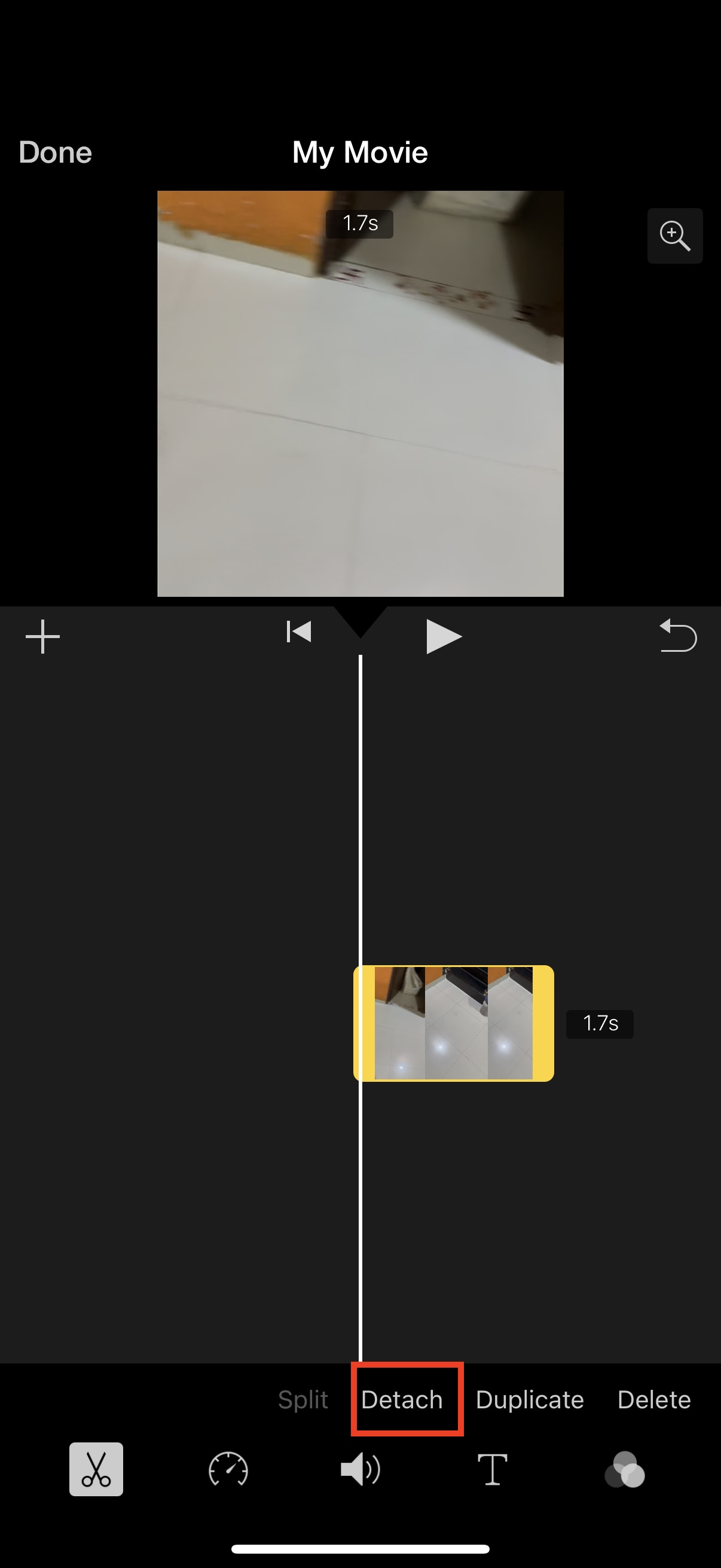
Step 4
Now tap the plus (+) icon and import your final video. Once the second video is imported, adjust the detached audio accordingly and use the music in the new video file before deleting the first video.
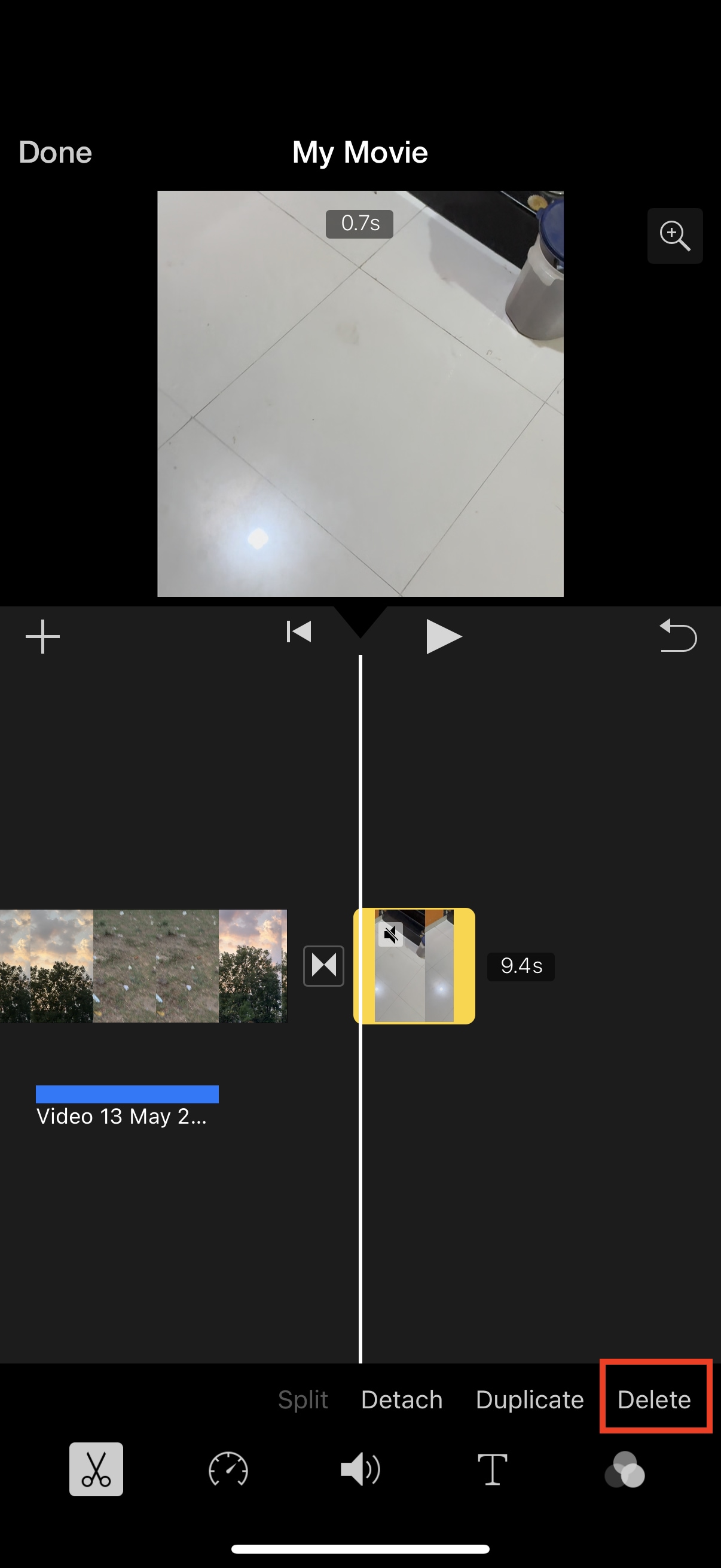
Part 3: How to Add Music to iMovie on Mac Using Built-in Music Resources
While iMovie on iPhone offers ready-to-use “Soundtracks,” the Mac version handles it differently. On macOS, built-in music resources include Apple's sound effects and any audio one has created in GarageBand or saved in their Music app library (non-DRM only).
Here’s how you can add built-in music or sound effects to your project in iMovie on Mac:
Step 1
Open iMovie on your Mac and click Create New > Movie. This launches a new project with an empty timeline.

Step 2
Before adding audio, drag your video clip into the timeline so that you can sync your sound effects or music correctly with the visuals.
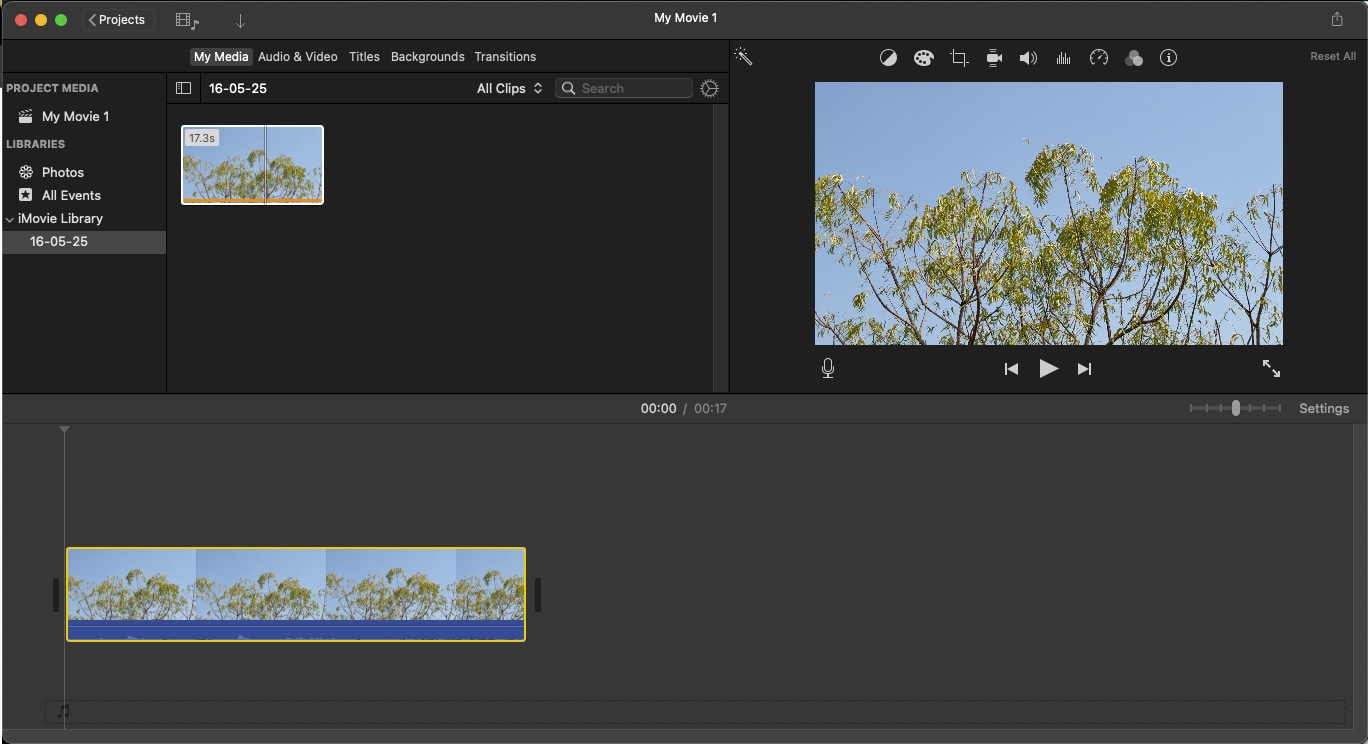
Step 3
Click on the Audio & Video tab from the top toolbar. In the left panel, select Sound Effects to explore Apple’s default sound library. You can also check the Music tab if you have synced non-DRM tracks through the Music app.
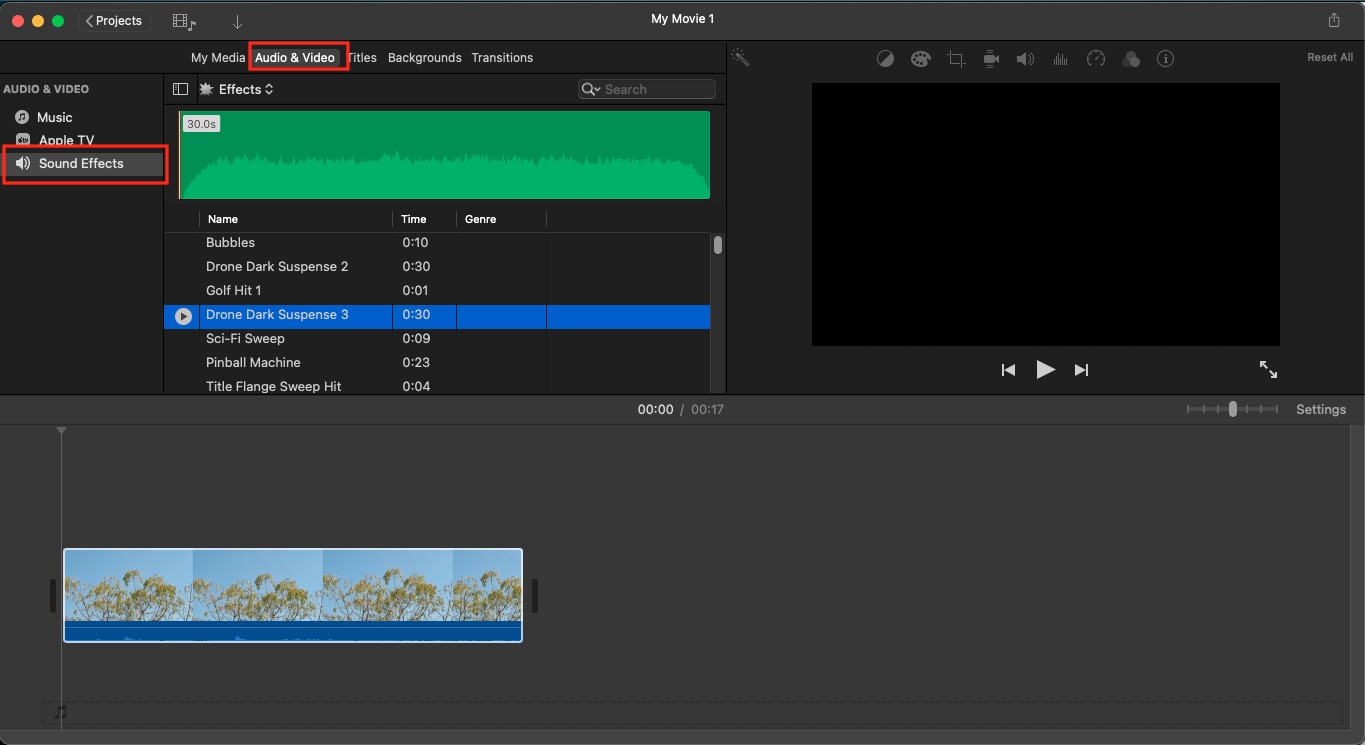
Step 4
Once you find a sound effect you like, simply drag it onto the timeline below your video track. It will appear as a green audio bar; you can trim, extend, or reposition it as needed.
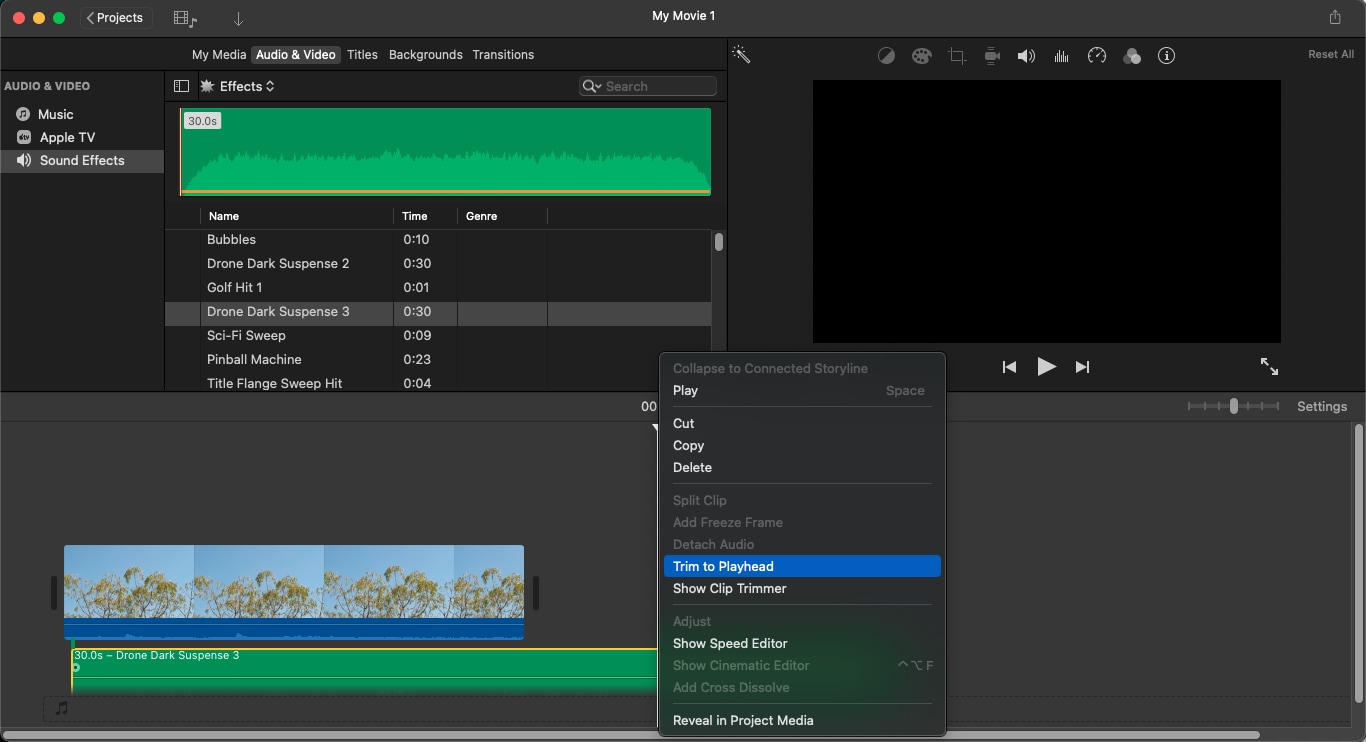
Video Sound Effect Enhancer on Win and Mac
Part 4: How to Add Music to iMovie on Mac Using Audio from Uploaded Video Files
Similarly to the iPhone, you can have a video clip on your system and use its music in another video by importing it into your iMovie. This is a great workaround if you do not have the music file separately.
Here’s how you can do it:
Step 1
Click Import Media and select the video file that contains the audio you want to extract. Drag this clip into your timeline.

Step 2
Right-click on the video clip in the timeline and choose Detach Audio. iMovie will automatically split the audio into a separate green track below the video layer.
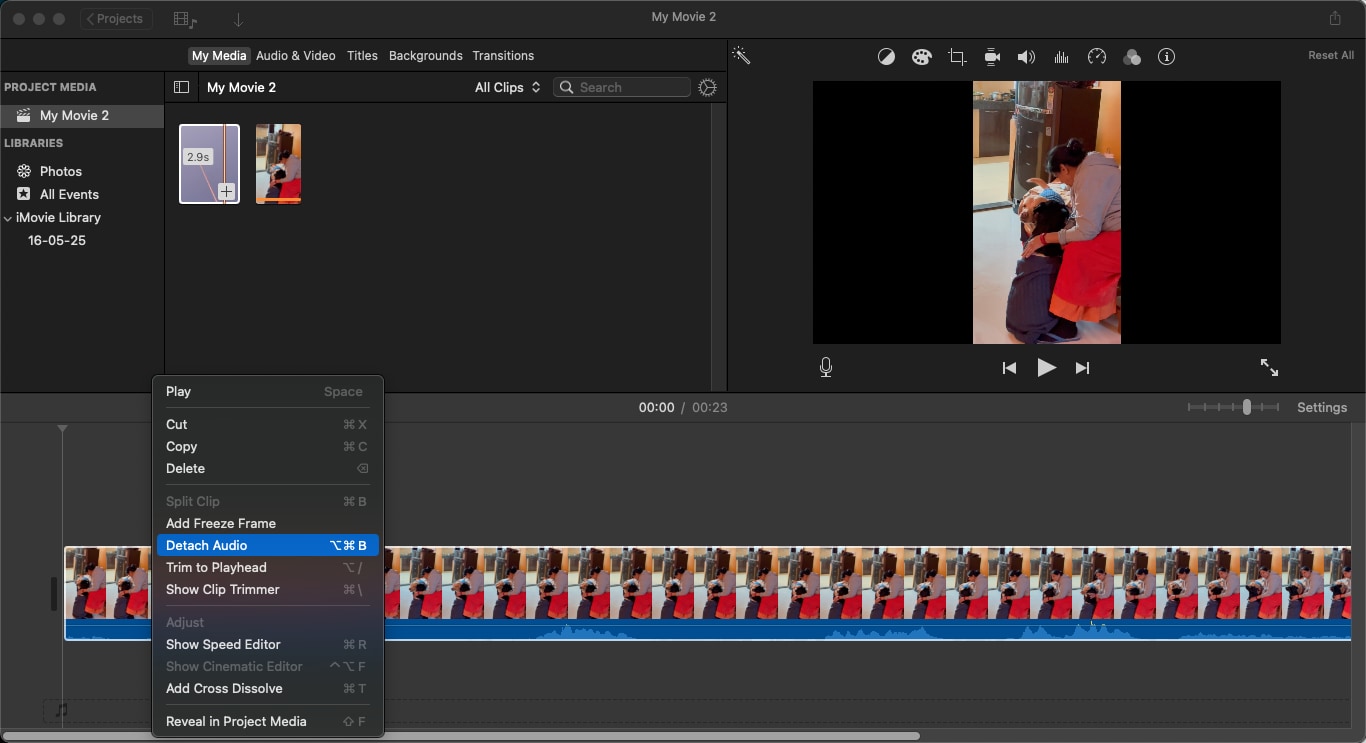
Step 3
Now import or drag the new video footage you want to use. Place it on the timeline either before or after the original clip.
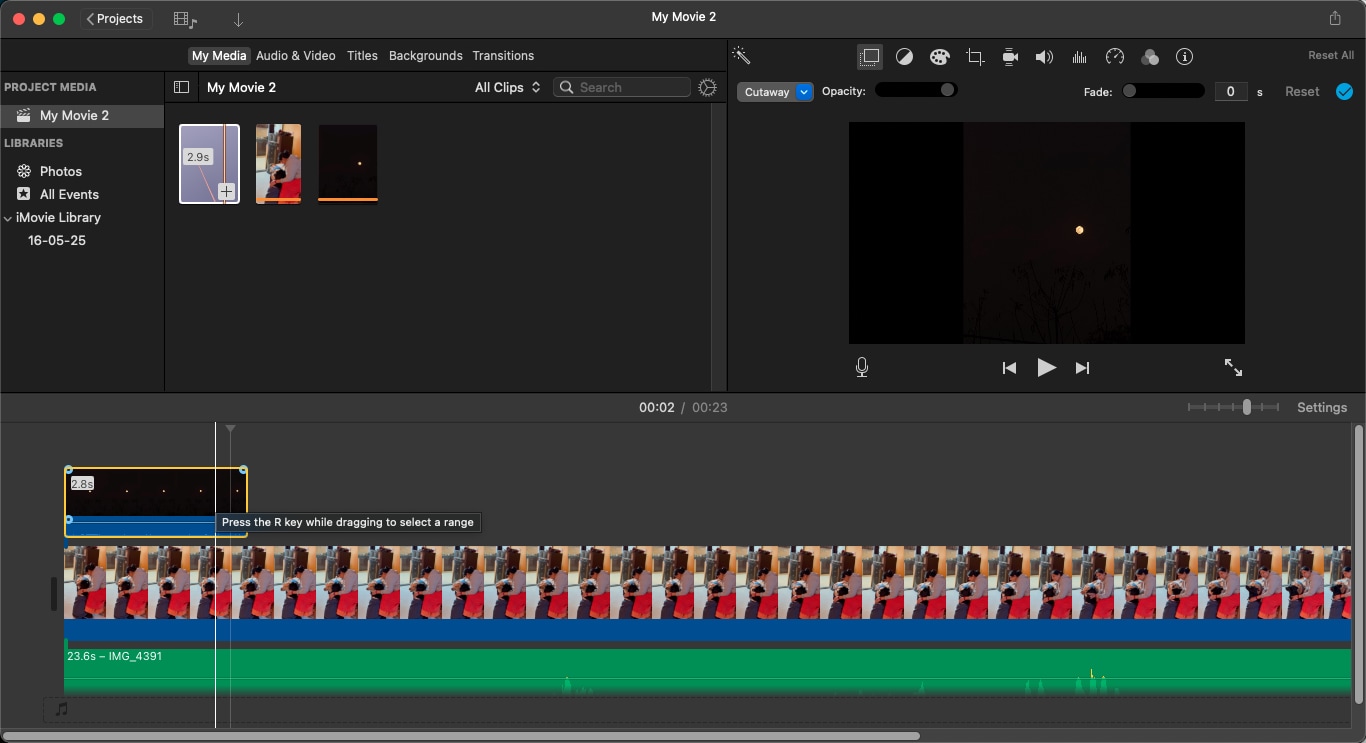
Step 4
Click on the original video clip (the one whose audio you just detached) and hit Delete. The audio will remain in place, now paired with your new visual that you can easily adjust.
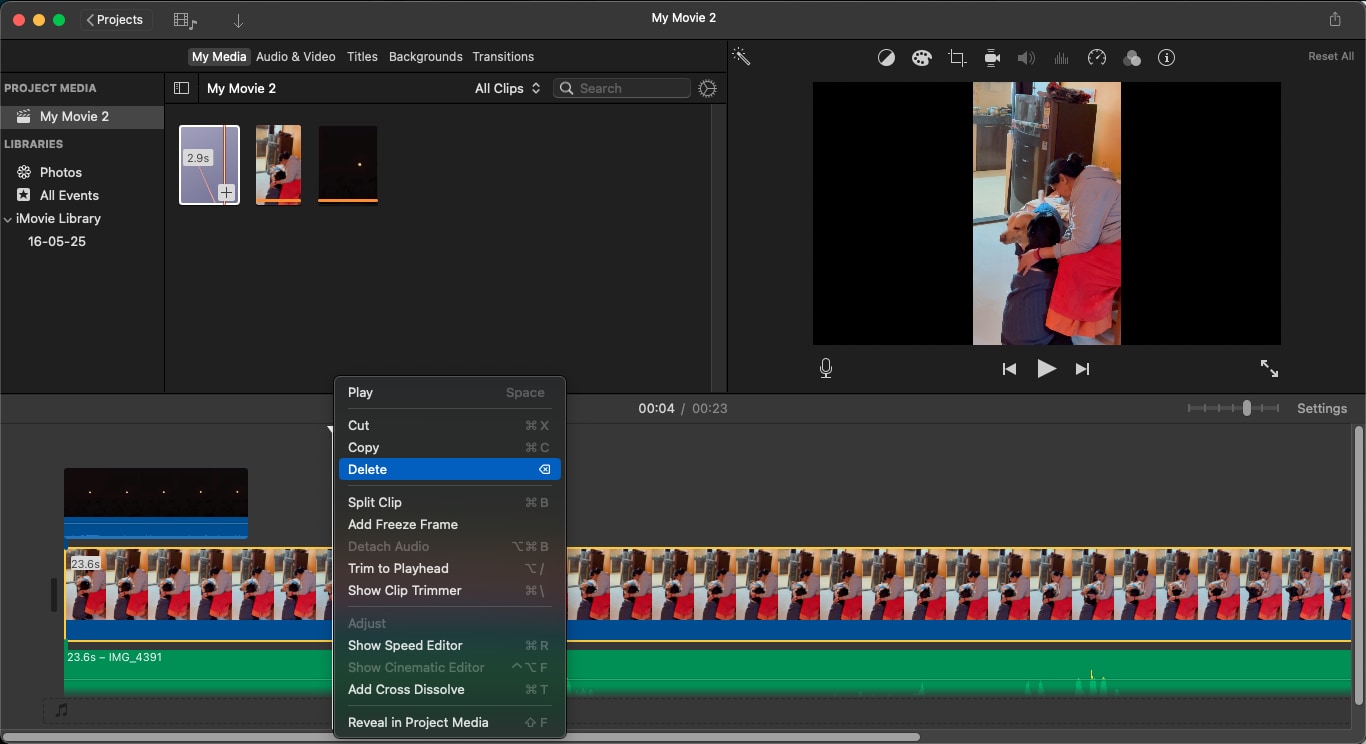
Part 5. How to Batch Enhance Video Sound or Stereo Effect
If your video clips suffer from uneven audio, low vocal clarity, or dull stereo output, UniConverter’s Video Editor offers a fast and effective way to batch-enhance them. Apart from basic editing tools like trimming and cropping, it has audio adjustment features that allow you to boost volume, improve stereo depth, and even apply fade effects for smoother transitions.
Step 1
Go to the Home screen of UniConverter, switch to the Video tab, and click on Video Editor under the available tools.
![]()
Step 2
Click Add Files and upload the videos you want to enhance. You can add multiple files in one go for batch editing.
![]()
Step 3
On the right panel, expand the Audio section and toggle the Adjust option. From here, you can now modify volume, voice enhancement, and change stereo output.
![]()
Step 4
Enable Fade In and Fade Out if you want smoother audio transitions. Once done, scroll down to Export Settings, choose your desired format (e.g., MP4, MOV), and click Export to save the enhanced videos.
![]()
*Tip:
Use Vocal Enhancement for clearer dialogue, especially in vlogs, interviews, or instructional videos.
Part 6: Conclusion
It won’t be wrong to say that great visuals deserve equally impactful audio. From using built-in soundtracks on iPhone to extract audio from a recorded clip on your MacBook, learning how to add music to iMovie gives you the creative control to shape your video’s tone and energy.
Now that you know how to insert music into iMovie, take it a step further and use UniConverter’s batch enhancement tools to fine-tune audio, adjust volume, and trim tracks before importing them to your iPhone or Mac for a more polished edit. Download UniConverter today and use the AI-powered feature to enhance your audio and video.
Video Sound Effect Enhancer on Win and Mac
FAQs
-
1. Can I add my own music to iMovie on iPhone?
Yes, you can add your own music to iMovie, provided the files are downloaded and not protected by DRM. Use iMovie's “My Music” tab to browse and add songs stored locally on your iPhone. If a track appears greyed out, it’s likely DRM-protected. -
2. How do you add background music to iMovie on iPhone?
Open your project in iMovie, tap the plus (+) icon, select Audio > Soundtracks or My Music, and choose a track that fits your video. Once selected, tap the plus (+) again to insert it into your timeline. You can then trim or adjust the volume to blend it seamlessly. -
3. Why can't I add Apple Music songs to iMovie?
Apple Music tracks are usually DRM-protected, meaning they can’t be imported into iMovie directly, even if they are downloaded. Only DRM-free music files or personally created content can be added to your iMovie project. -
4. How to remove DRM from Apple Music?
To remove DRM from Apple Music, you will need to purchase the track outright and use a third-party DRM removal tool. Keep in mind, removing DRM for non-personal use may violate Apple’s terms of service. -
5. Can you add free music to iMovie?
Yes, iMovie offers a wide range of free soundtracks and sound effects under the Audio section. You can also import royalty-free music from external sources, as long as the files are DRM-free and in supported formats like MP3 or WAV.



